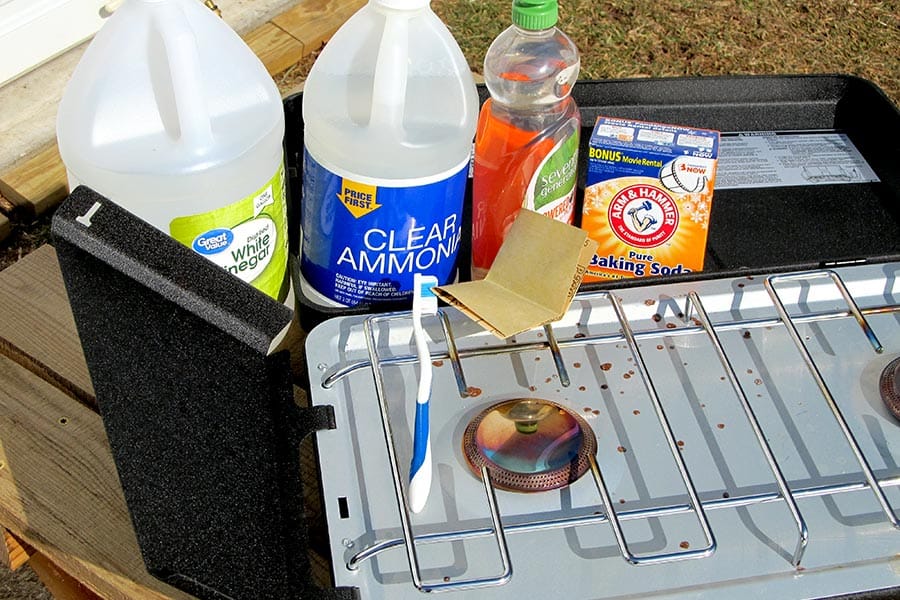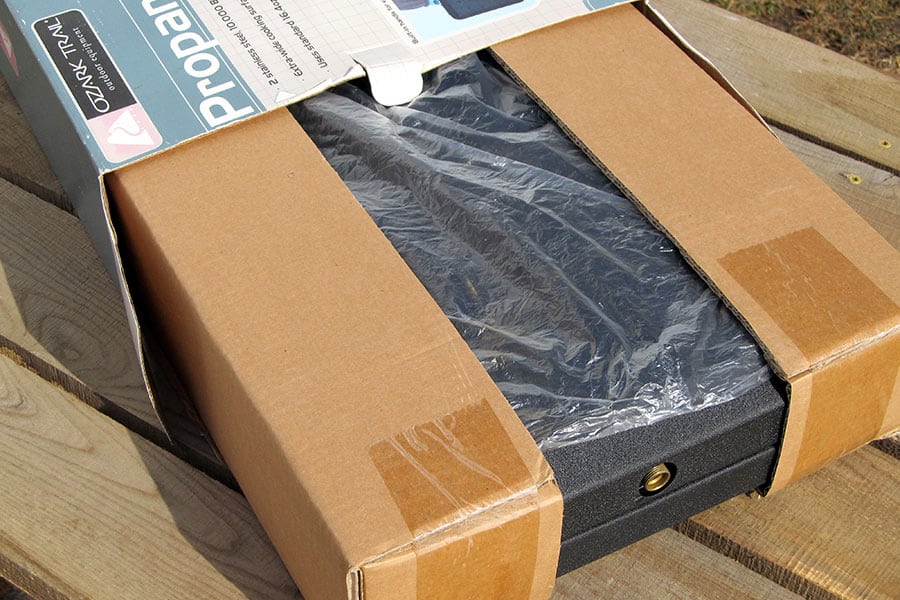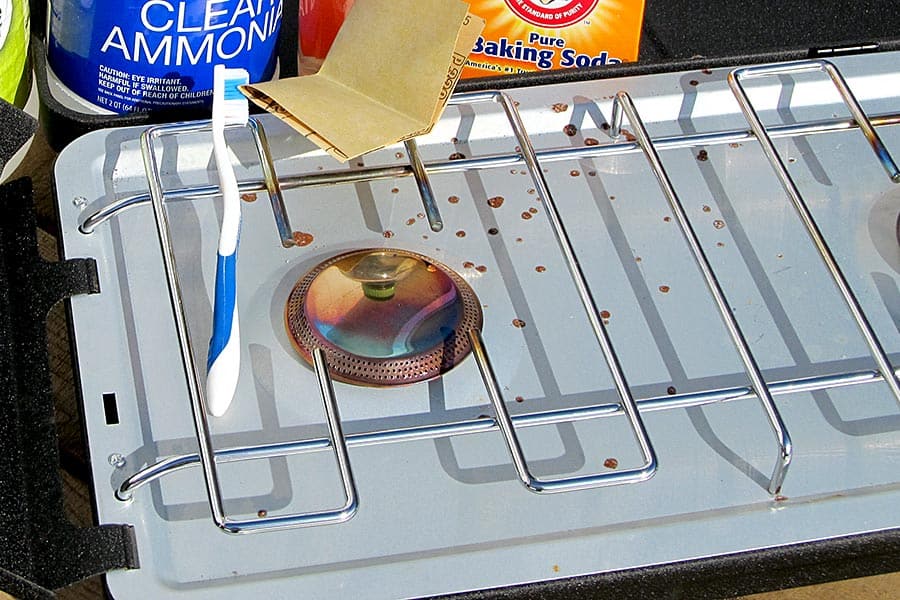
A warm meal does wonders for the body after a long day of exploring the great outdoors. A stove that is ready to fire up and cook that meal is essential to keeping everyone happy. So, knowing how to clean a camping stove and its burners is key to enjoying your time in nature.
So, how do you clean your camping stove and burners? You can keep your camping stove and burners clean with these 16 tips:
- Drain the fuel from your stove before cleaning.
- Use baking soda and vinegar to clean your stainless-steel.
- Polish your stainless-steel burner or stove with olive oil.
- Keep it simple with painted plastic or metal.
- Store your stove the right way to keep it clean in the off-season, too.
- Use an old wire brush or toothbrush to scrub the burners.
- Consistency is key with dials and knobs.
- Soak the baked-on grill grease.
- Take your stove to the car wash.
- Dry your stove upside down.
- Remove the rust the moment you see it.
- Deal with boil-overs immediately.
- Use a baking soda paste for stove-top burners.
- Steam clean with your oven at home.
- If all else fails, ammonia should do the trick.
- Skip the stove and use the campfire.
How you clean your stove varies quite a bit on the type of stove, fuel, and cooking that you do. From a multi-burner glamping stove to an ultralight burner, there are different ways to clean each one. This post will further discuss these 16 ways to clean your camping stove and burners.
Drain The Fuel From Your Stove Before Cleaning
All camping stoves need to be appropriately drained of fuel to ensure a long stove life and to clean them safely. Before beginning to clean, make sure your stove is off, and you have drained the gas, propane, or liquid from the line.
To do this, turn the knob off the propane tank or another fuel tank to stop the flow. Then, turn the stove on and light it to burn off any residual fuel left in the line.
We recommend burning the fuel off, but you can also let the gas escape or drip liquid fuel out of the line. If you use a propane stove, you will hear gas escaping for up to ten seconds, but then it should stop. When the fuel is no longer in the stove, it is safe to begin your deep clean.
Use Baking Soda And Vinegar To Clean Your Stainless-Steel
Stainless steel can be a tricky surface to clean, but if done correctly, it is one of the longest-lasting surfaces. Also, it can be beautiful if kept sparkly clean. So, begin by wiping down your stainless steel with white vinegar on a microfiber cloth.
Make sure to wipe or rub in the direction of the grain to decrease streaks and spots. While rubbing alcohol and other stainless-steel cleaners would also work, vinegar is the most environmentally friendly and easiest on the wallet.
For more stubborn spots, sprinkle some baking soda on the troublesome area. Then, continue to scrub with the vinegar rag. The chemical reaction between the two substances will help break up even the stickiest areas. Don’t worry, though, the chemical reaction is harmless to us.
Polish Your Stainless-Steel Burner Or Stove With Olive Oil
Olive oil is the key ingredient to keeping your stainless-steel easy to clean and free from smudges. Start with just a small dab on your cloth and wipe it onto your stainless-steel, staying in line with the grain.
This layer of oil creates a thin shield against smudges and water without making the stove greasy. Having this layer of olive oil will allow you to clean up in between meals much faster, which in turn makes the deep clean of your stove and burners much easier.
Keep It Simple With Painted Plastic Or Metal
When it comes down to it, simple is often best when it comes to cleaning. Painted plastic and metal require simple cleaning. These surfaces are specially treated with high-heat resistant paint, making it essential not to use abrasive chemicals that would peel the paint off.
Painted plastic and metal surfaces respond best to hot water and dish soap. You will want a good scrubbing sponge but stay away from steel wool or anything too abrasive that would scratch the paint. A standard dish sponge, dishcloth, or even an old t-shirt will do.

Store Your Stove The Right Way To Keep It Clean In The Off-Season
Cleaning gear when you get it out after some time in storage shouldn’t be stressful. You shouldn’t have to clean something coming out of storage at all if stowed away properly.
One of the simplest ways to store your stove well is to put it back in its original packaging. While it may take up a bit more space than other ways, it will be safe from bumps, scrapes, and dust.
If you have already thrown away the box, that’s okay. Grab a two-gallon Ziploc bag and place the stove inside. If your stove doesn’t fit in there, wrap it in a trash bag and tie it tightly. Storing in a trash bag will keep spiders and mice from making their nests inside.
Use An Old Wire Brush Or Toothbrush To Scrub The Burners
Note the place on your stove that creates the flame. These are the burners, and they are the heart and soul of your camp stove. They should have a myriad of different holes in them where the fuel comes out to burn. It is so important that these are all clear for an even and safe flame.
To clean the burners of your camping stove, follow these steps:
- Unscrew the burners from the base.
- Scrub the burner holes with hot water and dish soap.
- You can use a paper clip or safety pin to poke out any residue stuck in the holes.
- Thoroughly rinse the burner with warm water.
- Let it air dry for four to six hours.
It is essential to let the burners fully dry before you try to relight them, or they may not light due to the moisture still inside of them. If they do not light, you will be releasing the flammable gas into your area, which can be dangerous in large quantities.
Consistency Is Key With Dials And Knobs
Dials can be some of the trickiest items to keep clean. The best way to keep these clean is to give them a quick wipe whenever you cook. While that sounds nice, sometimes we do not have the time when we are heading out for our next big hike.
For a deeper clean, most knobs pop right off if you pull them gently away from the stove. Use a toothbrush to clean inside the knob while using the appropriate cleaner to clean the space they were covering up. Clean daily if you are using your stove quite a bit. Clean knobs will also give you the most control over your flame and heat output as well.
Soak The Baked-On Grill Grease
If your camping stove is more of a mini kitchen, you may have a grill on it. Hopefully, many kebabs have been roasted over it, which means there may be quite a layer of build-up on the camp stove.
While many people enjoy burning off excess food on the grill, that may not be an option if you are trying to conserve fuel while out on an adventure. Instead, you will need to get your scrubbing mojo on, along with a wire brush and hot, soapy water.
Scrubbing the grill is just about your only option for tough, baked-on spots. However, if you have a tub big enough, you can soak it in hot water to help loosen up some of the grime.
Take Your Stove To The Car Wash
Pressure washing is spectacular for your deck, siding, and camp stove. If the stove is caked with layers of old food, grease, and who knows what else, it may be time to bring out a pressure washer.
If you don’t have a pressure washer, pack the stove into the van and take it to the local car wash. Car washes often have high-pressure hoses, and they can be just what you need to get the gunk off your stove with a few quick sprays. Of course, if you’re already there, you might as well tidy your van inside and out.
Dry Your Stove Upside Down
Air drying is the most economical method for drying, and it is also the best for your stove’s longevity. To ensure the stove dries thoroughly, remove as many pieces out of your stove as you can. Doing this may involve disconnecting the hose, unscrewing the burners, and whatever else you can take off without too much hassle.
The more airflow it has, the better it will dry. So, turn everything upside down to ensure the water flows out and does not puddle anywhere inside. If water can puddle, it will interact with the metal and air, creating rust. Rust is the last thing you want, as it eats away at your stove.

Remove Rust The Moment You See It
Rust is like a bad parasite. It can spread quickly and destroy everything in its path. If you do spot any rust on your stove or burners, address it immediately.
Take a grill stone or steel wool and scrub the rust away. You can also use wet-or-dry sandpaper to scrub if you have that on hand instead. Keep in mind that the warmer the rust is, the easier it will come off. So, this is a great thing to do after you have finished cooking, and the elements are still warm. Scrub and scrape it off until you do not see any more rust. If there is even a little bit of it left, it will keep eating away at the metal.
Once you have removed all of the rust, refer to tip number three and make sure your metal has a protective coat of oil to keep air and water off the surface.
Other Posts of Interest
- Why We Bought A Yeti Cooler
- 11 Best Options For Camper Van Toilets And Showers
- Van Camping vs. Tent Camping: What Is Better for You?
Deal With Boil-Overs Immediately
Boiling over a pot of water or soup can be one of the biggest causes of rust. So, while it is not fun, drying your stove out thoroughly after a boil over is necessary.
To do so, make sure to unscrew the burners and use a rag or towel to soak up as much water as you can. If you have time, flip it upside down to dry. Often you need to pack up and move on quickly after a meal, though. If you can, try to use it for the next meal on high heat. Using the stove will help dry any moisture left from the previous meal.
Use A Baking Soda Paste For Stove Top Burners
If your camping stove burners have a grate, then they may have quite a build-up of food, grease, and who knows what else. While scrubbing with a sponge and soap is an option, try making a paste of baking soda and water to put on them.
After this paste sits for twenty minutes or so, it will have begun to break up the baked-on residue. You should be able to scrub it off with a sponge after this. This trick is quick, easy, and cheap.
Steam Clean With Your Oven At Home
How does your oven at home clean itself? Some use high heat for baking off the residue, while others steam clean.
Check your oven’s cleaning options. If you have a steam-cleaning option, it probably entails putting a cup of water in the bottom of the oven then pressing the clean button. It will heat up and steam everything inside, loosening up dirt and grime. All you must do is put your stove inside, and it will get clean, too.
So, if you have an all-metal camping stove with caked-on food or metal burners that have this, go ahead and toss them in your oven during this cycle. Keep in mind that you cannot have any plastic pieces or rubber tubing in the oven, as it will melt.
If All Else Fails, Ammonia Should Do The Trick
If your camping stove or burners have outlasted every trick in the book so far, then it is time to bring in the ammonia. As a harsh and smelly chemical, this should be a last resort.
Pour a quarter cup of ammonia into a plastic bag with your greasy stove piece. Slosh it around to make sure everything has been entirely covered with ammonia, then let it rest. Make sure it is out of reach of children and pets as it soaks. Let it rest overnight in your sink.
The next morning, pour the ammonia out carefully and run the element thoroughly under the water in the sink. You do not want any trace of ammonia left, so it does not contaminate you or the food.
Skip The Stove, And Use The Campfire
Using the campfire may sound funny, but for thousands of years, meals were cooked over a fire instead of a stove. Grab a roasting stick and build yourself a fire. Then, skewer your hot dog, and in no time, you will have a delicious dinner.
The best part about this is if you have little ones to entertain, they can be collecting the firewood and whittling the sticks. Doing this will occupy them until they have to cook their dinner. With this, your stove will be able to take a night off, keeping it clean for one more day. You also do not have to set up or break down the kitchen if you are only staying one night.
Another option to use while cooking over a campfire is to use pie irons, read our pie iron post here. Do note that before opting for the campfire cooking method, you need to check local regulations to see if you can have a campfire. Also, knowing how to build a fire safely and effectively is essential.
Benefits Of Cleaning Your Camping Stove And Burners
Keeping your stove and burners clean is one of the best ways to keep you and your loved ones safe and healthy while out camping. Sanitation in between meals keeps bacteria at bay, allowing you to perform at your best for whatever each day has in store. Whether you’re simply enjoying a day parked down by the beach, or you’ve driven into the backcountry, steering clear of any contamination is critical.
It should not be surprising that a clean stove works much better than a dirty one. A stove and burners that are clean will give you greater control over the flame and heat. Besides, this should improve your fuel efficiency, making your money stretch a little further. Remember to take care of your tools, and they will take care of you.
Using These Tips And Tricks For Life-Long Fun
Remember that consistency is key when cleaning. If you can put something away every time you use it, you never get overwhelmed with a cluttered space. The same goes for cooking.
If you can give your stove a quick wipe after every use, you will be prolonging the life of your stove. At the end of each trip, give it a deeper clean and a light coat of oil. By doing this, you should be able to pass the stove on for generations.





